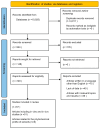Salvia verticillata (L.)-Biological Activity, Chemical Profile, and Future Perspectives
- PMID: 39065710
- PMCID: PMC11280111
- DOI: 10.3390/ph17070859
Salvia verticillata (L.)-Biological Activity, Chemical Profile, and Future Perspectives
Abstract
Species belonging to the genus Salvia, Lamiaceae, have been deeply involved in the folk medicine of different nations since ancient times. Lilac sage, or Salvia verticillata L. (S. verticillata) is a less studied species from the genus. However, it seems to have a prominent potential for the future drug discovery strategies of novel phytopharmaceuticals. This review aims to summarise the data on the biological activity and the phytochemical profile of extracts and essential oils derived from S. verticillata. This review is based on data from 57 in vitro and in vivo studies. The chemical profile of S. verticillata includes different synergic compounds like phenolic acids, flavonoids, terpenes, and salvianolic acids. Although some small amounts of salvianolic acid B were found in S. verticillata extracts, the major compound among the salvianolic acids is salvianolic acid C, a compound associated with the potential for improving liver fibrosis, cardio- and hepatoprotection, and the inhibition of SARS-CoV-2 infection. The cannabinoid type 2 receptor agonist β-caryophyllene is one of the major compounds in S. verticillata essential oils. It is a compound with a prominent potential in regenerative medicine, neurology, immunology, and other medical fields. The in vivo and the in vitro studies, regarding S. verticillata highlighted good antioxidant potential, anti-inflammatory, antibacterial, and antifungal activity. S.verticillata was also reported as a potential source of drug candidates for the treatment of neurodegenerative diseases such as Alzheimer's disease, because of the inhibitory activity on the acetylcholinesterase. However, the number of studies in this direction is limited.
Keywords: Salvia; Salvia verticillata; essential oils; folk medicine; phytopharmaceuticals; salvianolic acid C; salvianolic acids; β-caryophyllene.
Conflict of interest statement
The authors declare no conflicts of interest.
Figures




Similar articles
-
Salvia verticillata: Linking glandular trichomes, volatiles and pollinators.Phytochemistry. 2018 Nov;155:53-60. doi: 10.1016/j.phytochem.2018.07.016. Epub 2018 Aug 1. Phytochemistry. 2018. PMID: 30077120
-
In Vitro Antibacterial, Antioxidant, Anticholinesterase, and Antidiabetic Activities and Chemical Composition of Salvia balansae.Molecules. 2023 Nov 27;28(23):7801. doi: 10.3390/molecules28237801. Molecules. 2023. PMID: 38067531 Free PMC article.
-
Effect-Directed Analysis for the Antioxidant Compound in Salvia verticillata.Iran J Pharm Res. 2016 Winter;15(1):241-6. Iran J Pharm Res. 2016. PMID: 27610164 Free PMC article.
-
Ethnopharmacology, phytochemistry, and pharmacology of Chinese Salvia species: A review.J Ethnopharmacol. 2018 Oct 28;225:18-30. doi: 10.1016/j.jep.2018.06.029. Epub 2018 Jun 20. J Ethnopharmacol. 2018. PMID: 29935346 Review.
-
Genus Echinophora-Biological Activity, Chemical Composition, and Future Perspectives.Plants (Basel). 2024 Jun 8;13(12):1599. doi: 10.3390/plants13121599. Plants (Basel). 2024. PMID: 38931031 Free PMC article. Review.
Cited by
-
Subchronic Toxicity and Effect of the Methanolic Extract of Micromeria frivaldszkyana (Degen) Velen on Cognition in Male Wistar Rats.Plants (Basel). 2025 Jun 15;14(12):1837. doi: 10.3390/plants14121837. Plants (Basel). 2025. PMID: 40573825 Free PMC article.
References
-
- Katanić Stanković J.S., Srećković N., Mišić D., Gašić U., Imbimbo P., Monti D.M., Mihailović V. Bioactivity, Biocompatibility and Phytochemical Assessment of Lilac Sage, Salvia verticillata L. (Lamiaceae)—A Plant Rich in Rosmarinic Acid. Ind. Crops Prod. 2020;143:111932. doi: 10.1016/j.indcrop.2019.111932. - DOI
-
- Altun M., Ünal M., Kocagöz T., Gören A.C. Essential Oil Compositions and Antimicrobial Activity of Salvia Species. J. Essent. Oil Bear. Plants. 2007;10:251–258. doi: 10.1080/0972060X.2007.10643550. - DOI
-
- Asadollahi M., Firuzi O., Heidary Jamebozorgi F., Alizadeh M., Jassbi A.R. Ethnopharmacological Studies, Chemical Composition, Antibacterial and Cytotoxic Activities of Essential Oils of Eleven Salvia in Iran. J. Herb. Med. 2019;17–18:100250. doi: 10.1016/j.hermed.2018.11.006. - DOI
-
- Çadirci E., Süleyman H., Gürbüz P., Uz A., Güvenalp Z., Demirezer L.Ö. Anti-Inflammatory Effects of Different Extracts from Three Salvia Species. Turk. J. Biol. 2012;36:8. doi: 10.3906/biy-1001-17. - DOI
Publication types
LinkOut - more resources
Full Text Sources
Miscellaneous

